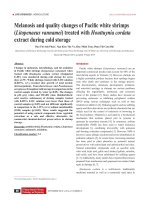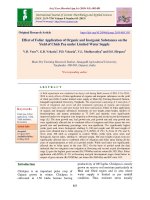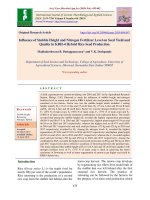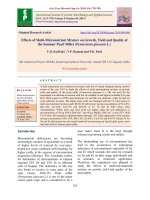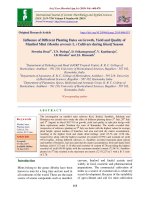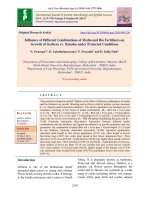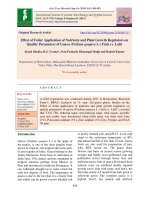Foliar applications of calcium, magnesium and iron influence yield and quality of Guava cv. Sardar
Bạn đang xem bản rút gọn của tài liệu. Xem và tải ngay bản đầy đủ của tài liệu tại đây (449.56 KB, 9 trang )
Int.J.Curr.Microbiol.App.Sci (2019) 8(9): 3016-3024
International Journal of Current Microbiology and Applied Sciences
ISSN: 2319-7706 Volume 8 Number 09 (2019)
Journal homepage:
Original Research Article
/>
Foliar Applications of Calcium, Magnesium and Iron Influence Yield and
Quality of Guava cv. Sardar
Jitendra Kumar1*, Alka Arya2, Manpreet Singh1,
Shailesh Tripathi1 and Rajesh Kumar1
1
Department of Horticulture, 2Department of Soil Science, College of Agriculture, G.B. Pant
University of Agriculture and Technology, Pantnagar, Uttarakhand ‒ 263145, India
*Corresponding author
ABSTRACT
Keywords
Guava, calcium,
magnesium, iron,
nutrient, foliar
spray, yield, quality
Article Info
Accepted:
04 August 2019
Available Online:
10 September 2019
The present experiment was conducted to evaluate the effect of foliar
sprays of calcium, magnesium and iron to guava trees for rainy season crop.
The yield on per hectare basis and total sugar content from fresh fruits was
estimated by standard procedures. Study showed that fruit yield and total
sugars content increased significantly with foliar application of calcium,
magnesium and iron.
Introduction
Guava (Psidium guajava L.) is one of the most
important fruit crops in the world. It belongs
to the family myrtaceae. Guava has the
chromosome count of 2n=22. It is grown in
tropical, sub-tropical and some parts of arid
regions in the world. The guava originated in
tropical America, probably in an area
extending from Mexico to Peru (Chandler,
1958). It is a very rich source of vitamin-C,
carbohydrates, iron and fat, and contains a fair
amount of calcium and phosphorous as well,
which enhance its nutritional values (Kumar et
al., 2017). India is leading producers of guava
in the world. Other major guava producing
countries in the world are China, Thailand,
Mexico, Indonesia, Pakistan and Brazil. In
India, guava is cultivated in an area of 265
thousand hectares with production of 4054
thousand MT and productivity of 15.29 MT/ha
(Horticultural Statistics, 2018). Major guava
producing states in India are Madhya Pradesh,
Uttar Pradesh, Bihar, Andhra Pradesh and
Maharashtra.
Availability of guava fruits is throughout the
year. Although, the yield of rainy season crop
is much higher as compared to the winter
season crop but the quality of fruits is
relatively very poor (Kumar et al., 2015)
might be due to loss of nutrients leach in
3016
Int.J.Curr.Microbiol.App.Sci (2019) 8(9): 3016-3024
heavy rains. Foliar fertilization could be
considerably lucrative when soil nutrient
management practices are limiting. Foliar
fertilization is an important tool for the
sustainable and productive management of
crops (Fernandez et al., 2013). Improvement
in yield and quality of fruits by foliar
application of calcium, magnesium and iron
has already been well documented by previous
workers (Kumar et al., 2017; Shi et al., 2018;
Chater and Garner, 2019). Calcium is required
for cell elongation and cell division
(Burstrom, 1968). Magnesium has important
role in photosynthesis as it is primary
constituent of chlorophyll (Hao and
Papadopoulos, 2004). Iron has important role
in activating biosynthesis of chlorophyll,
biosynthesis of cytochromes and transfer of
electrons in biological oxidation (Neuweiler et
al., 1996). These plant nutrients are directly or
indirectly involved in biosynthesis and
activation of many enzymes which require in
different biochemical processes essential for
plant metabolism. Keeping in view these
points, the study has been conducted to
evaluate the effect of foliar sprays of calcium,
magnesium and iron for improving yield and
fruit quality of guava.
Materials and Methods
The present investigation was carried out at
Horticultural Research Centre, Patharchatta,
Department of Horticulture, Govind Ballabh
Pant University of Agriculture and
Technology, Pantnagar, Udham Singh Nagar
(Uttarakhand) during year 2016-17 and 201718. Pantnagar is situated in the foot hills of
Himalaya at an altitude of 243.84 meters
above the mean sea level and lies between
29ºN latitude and 79.3ºE longitude. The region
is characterized by humid subtropical climate
with maximum temperature ranging from
30°C to 43ºC in summer and minimum
ranging from 0 to 9 ºC in winter. The summers
are hot and dry, winters are cold and rains are
heavy (average rainfall 1400 mm). Monsoon
occurs from the third week of June to the
middle of September. July and August are the
wettest months in the year (mean 350-425 mm
rainfall). Frost can be expected from the last
week of December to middle of February.
Occasionally, light rains are expected during
winter (Figure 1). The soil of Tarai region
have been developed from calcareous,
medium to coarse textured materials under
predominant influence of tall vegetation and
moderate to well drained conditions. The soil
of the experimental plot has been classified as
series VI (sandy loam under the order
Mollisol) of Patharchatta. Soil is moderately
dark in colour, well drained and developed
from loamy alluvial sediments averaging 0.6
to 1.0 meter thick over loamy sand, sand or
gravel (Deshpande et al., 1971).
The guava cv. Sardar was used as
experimental material for the present
investigation. Its fruits are large, roundish
ovate in shape, skin primrose yellow and pulp
white, very sweet and tasty. The total soluble
solids (TSS) and vitamin C contents are high.
The trees are vigorous. Ten year old 63
uniform trees of guava cv. Sardar comprised
the plant materials. These plants were planted
in a hedge row system of planting at 8 × 4 m2
distance. All the trees were maintained under
uniform cultural operations throughout the
period of experiment.
The experiment was laid out under completely
Randomized Block Design given by Cochran
and Cox (1992). The experiment consisted of
21 treatments (Table 1) which are replicated 3
times. Application of calcium chloride,
magnesium sulphate and ferrous sulphate was
given to the 10 years aged healthy and
uniform trees of guava cv. Sardar. The foliar
application of plant nutrients was given as
liquid sprays by using knapsack sprayer.
Foliar sprays of nutrients were given two
times; first just after fruit set and second one
3017
Int.J.Curr.Microbiol.App.Sci (2019) 8(9): 3016-3024
month after first spray. The data on the fruit
yield per tree was recorded by weighing all the
fruits in each treatment, replication wise at the
time of harvesting by using the electric
balance of 20 kg capacity and calculated on
the basis of number of plants per hectare in
tons. Total sugars were estimated as described
by Ranganna (1986). The significance of
variance among the treatments was analyzed
by applying the ‘F-test’ (Fisher, 1935) and
critical difference at five percent level was
calculated to compare the mean values of
treatments for all the characters.
Results and Discussion
Perusal of the data regarding to effect of
calcium, magnesium and iron sprays on yield
of guava reveals that yield was significantly
influenced by the application of calcium,
magnesium and iron during both the years
2016 and 2017, and with pooled (Table 2,
Figure 2). During 2016-17, the data pertaining
to yield of guava showed that maximum yield
(13.49 t/ha) was recorded with the treatment
T21 [FeSO4 (0.6%) + CaCl2 (0.6%) + MgSO4
(0.6%)] followed by T20 (11.64 t/ha). Whereas,
minimum yield (9.23 t/ha) was observed under
the treatment T1 (control) which was
statistically at par with T2, T3, T4, T5, T6, T7,
T8, T11, T14, T15, T16 and T19. However, rest of
the treatments had significantly higher yield.
During 2017-18, maximum yield (14.06 t/ha)
was recorded under the treatment T21 [FeSO4
(0.6%) + CaCl2 (0.6%) + MgSO4 (0.6%)]
which was statistically at par with T20.
However, rest of the treatments had
significantly lower yield. Whereas, minimum
yield (8.71 t/ha) was observed with the
treatment T1 (control). Analysis of pooled
means of both the years 2016-17 and 2017-18
indicates that maximum yield (13.78 t/ha) was
recorded with the treatment T21. Whereas,
minimum yield (8.97 t/ha) was observed with
the treatment T1 (control).
Magnesium has been reported to have
important role in increasing overall plant
growth and yield due to its stimulatory effect
on plant metabolism (Devlin, 1966). Also the
growth and yield might have been augmented
due to higher synthesis of nucleic acid.
Magnesium also participates in enzymatic
activities involved in protein synthesis and cell
multiplication. The increase in the yield in
magnesium treated plants may be on account
of maximum availability of plant metabolism
(Bangali et al., 1993). The present study is in
line with the findings of Majer (2004) who
reported that the application of magnesium
increased fruit yield in grapevine. According
to Chaturvedi et al., (2005), iron in
combination with zinc has been reported to
increase the yield of strawberry. Bhoyar and
Ramdevputra (2016) noticed that 0.5% ferrous
sulphate application recorded maximum yield
in guava cv. Sardar than zinc and borax. Iron
deficiency causes decreases in fruit yield and
quality peach (Almaliotis et al., 1995).
According to Zaiter et al., (1993), significant
increases in yield of strawberry cultivars were
obtained when they were sprayed with iron.
Similar findings have also been reported in
pear by Alvarez-Fernandez et al., (2011), by
El-Kassas (1984) in citrus, by Yadav et al.,
(2013) in peach and by Jagtap et al., (2013) in
acid lime.
The data on total sugars mentioned in Table 2
and Figure 3 showed that total sugars were
significantly influenced by the application of
calcium, magnesium and iron during both the
years 2016-17 and 2017-18, and with pooled.
During 2016-17, maximum total sugars
(6.94%) was recorded with the treatment T21
[FeSO4 (0.6%) + CaCl2 (0.6%) + MgSO4
(0.6%)] which was statistically at par with the
treatments T9, T10, T12, T13, T17, T18 and T20.
However, rest of the treatments had
significantly lower total sugars. Whereas,
minimum total sugars (4.65%) was observed
with the treatment T1 (control).
3018
Int.J.Curr.Microbiol.App.Sci (2019) 8(9): 3016-3024
Table.1 Details of the treatments
Treatments
T1
T2
T3
T4
T5
T6
T7
T8
T9
T10
T11
T12
T13
T14
T15
T16
T17
T18
T19
T20
T21
Details
Control
CaCl2 (0.3%) + MgSO4 (0.3%)
CaCl2 (0.3%) + MgSO4 (0.6%)
CaCl2 (0.6%) + MgSO4 (0.3%)
CaCl2 (0.6%) + MgSO4 (0.6%)
FeSO4 (0.3%) + MgSO4 (0.3%)
FeSO4 (0.3%) + MgSO4 (0.6%)
FeSO4 (0.3%) + CaCl2 (0.3%)
FeSO4 (0.3%) + CaCl2 (0.3%) + MgSO4 (0.3%)
FeSO4 (0.3%) + CaCl2 (0.3%) + MgSO4 (0.6%)
FeSO4 (0.3%) + CaCl2 (0.6%)
FeSO4 (0.3%) + CaCl2 (0.6%) + MgSO4 (0.3%)
FeSO4 (0.3%) + CaCl2 (0.6%) + MgSO4 (0.6%)
FeSO4 (0.6%) + MgSO4 (0.3%)
FeSO4 (0.6%) + MgSO4 (0.6%)
FeSO4 (0.6%) + CaCl2 (0.3%)
FeSO4 (0.6%) + CaCl2 (0.3%) + MgSO4 (0.3%)
FeSO4 (0.6%) + CaCl2 (0.3%) + MgSO4 (0.6%)
FeSO4 (0.6%) + CaCl2 (0.6%)
FeSO4 (0.6%) + CaCl2 (0.6%) + MgSO4 (0.3%)
FeSO4 (0.6%) + CaCl2 (0.6%) + MgSO4 (0.6%)
Table.2 Effect of calcium, magnesium and iron on yield (t/ha) of guava cv. Sardar
Treatments
T1
T2
T3
T4
T5
T6
T7
T8
T9
T10
T11
T12
T13
T14
T15
T16
T17
T18
T19
T20
T21
C.D. at 5% level of significance
SEm±
2016
9.23
10.65
10.32
10.74
9.99
11.08
10.08
10.03
11.32
11.33
10.45
11.06
11.10
10.27
10.17
10.32
10.92
11.10
10.13
11.64
13.49
1.78
0.62
Yield (t/ha)
2017
8.71
11.38
11.26
11.36
10.82
11.60
11.05
11.07
12.13
12.16
10.76
11.63
11.82
10.62
10.69
10.94
11.80
11.62
10.68
12.47
14.06
1.88
0.66
3019
Pooled
8.97
2016
4.65
11.01
10.79
11.05
10.41
11.34
10.57
10.54
11.73
11.74
10.60
11.35
11.46
10.45
10.43
10.63
11.36
11.36
10.40
12.05
13.78
1.26
0.44
5.01
5.13
5.15
5.26
5.03
5.16
5.07
6.23
6.49
5.18
6.56
6.73
5.18
5.28
5.20
6.63
6.77
5.38
6.89
6.94
1.00
0.35
Total Sugars (%)
2017
Pooled
4.64
4.65
5.01
5.23
5.28
5.89
5.10
5.30
5.15
6.35
6.43
5.35
6.44
6.67
5.41
6.04
5.63
6.58
6.79
6.23
6.89
7.00
1.04
0.36
5.01
5.18
5.21
5.58
5.07
5.24
5.11
6.29
6.46
5.27
6.50
6.70
5.29
5.66
5.42
6.60
6.78
5.80
6.89
6.97
0.64
0.23
Int.J.Curr.Microbiol.App.Sci (2019) 8(9): 3016-3024
Fig.1 Monthly average weather data during 2016 and 2017
3020
Int.J.Curr.Microbiol.App.Sci (2019) 8(9): 3016-3024
Fig.2 Effect of calcium, magnesium and iron on yield (t/ha) of guava cv. Sardar
Fig.3 Effect of calcium, magnesium and iron on total sugars (%) of guava cv. Sardar
3021
Int.J.Curr.Microbiol.App.Sci (2019) 8(9): 3016-3024
Data for the year 2017-18 showed that
maximum total sugars (7.00%) was recorded
with the treatment T21 [FeSO4 (0.6%) + CaCl2
(0.6%) + MgSO4 (0.6%)] which was
statistically at par with the treatments T9, T10,
T12, T13, T15, T17, T18, T19 and T20. However,
rest of the treatments had significantly lower
total sugars. Whereas, minimum total sugars
(4.64%) was recorded with the treatment T1
(control). Analysis of the pooled data
indicates that maximum total sugars (6.97%)
was recorded with the treatment T21 [FeSO4
(0.6%) + CaCl2 (0.6%) + MgSO4 (0.6%)]
which was statistically at par with the
treatments T9, T10, T12, T13, T17, T18 and T20.
However, rest of the treatments had
significantly lower total sugars. Whereas,
minimum total sugars (4.65%) was observed
with the treatment T1 (control).
The increase in total sugars may be because
of an increase in reducing sugars and nonreducing sugar resulting from conversion of
starch into simple sugar. This conversion of
starch into sugars is mediated by amylases
and involvement of calcium ions in activation
and regulation enzymes is documented by
Bush et al., (1989). The present results are in
agreement with the findings of Bisen et al.,
(2014), who reported that calcium alone or in
combination increased total sugars when
applied as pre-harvest foliar application on
guava. According to Ghosh and Besra (2000),
highest total sugar content was recorded when
iron was sprayed along with zinc and boron in
sweet orange. The investigation of Babu and
Yadav (2005) also supported the present
results as they noticed a significant increase in
total sugars in Khasi mandarin when sprayed
with 0.5 per cent each of magnesium,
manganese and zinc.
The present study reveals that two times foliar
application of 0.6 per cent each of calcium,
magnesium and iron as calcium chloride,
magnesium sulphate and ferrous sulphate
respectively, just after fruit set and again after
one month can improve fruit yield and quality
of fruits in terms of enhanced total sugars
content.
References
Almaliotis, D.D., Manganaris, A.G., Simonis,
A.D. and Bladenopoulou, S.B. 1995.
Rootstock effect on yield and mineral
nutrition of ‘Maycrest’ peach trees
under conditions of lime-induced
chlorosis. In: Abadia J. ed. Iron
nutrition in soils and plants. Kluwer
Academic Publishers, Dordrecht. pp.
301–306.
Alvarez-Fernandez, A., Melgar, J.C., Abadia,
J. and Abadia, A. 2011. Effects of
moderate and severe iron deficiency
chlorosis on fruit yield, appearance and
composition in pear (Pyrus communis
L.) and peach (Prunus persica L.
Batsch). Environ. Exp. Bot. 71: 280–
286.
Babu, K.D. and Yadav, D.S. 2005. Foliar
spray of micronutrients for yield and
quality improvement in Khasi mandarin
(Citrus reticulata Blanco.). Indian J.
Hortic. 62(3): 280-281.
Bangali, A.N., Hulamani, N.C. and Sulikeri,
G.S. 1993. Effect of foliar application
of zinc magnesium and boron on growth
and yield of guava (Psidium guajava L.)
cv. Sardar. Karnataka J. Agric. Sci.
6(2): 137-141.
Bhoyar, M.G. and Ramdevputra, M.V. 2016.
Effect of foliar spray of zinc, iron and
boron on the growth, yield and sensory
characters of guava (Psidium guajava
L.) cv. Sardar L-49. J. Appl. Nat. Sci.
8(2): 701-704.
Bisen, S., Thakur, R.S. and Tembhare, D.
2014. Effect of calcium nitrate and
gibberellic acid application on growth,
fruit quality and post-harvest behaviour
of guava fruit. The Ecoscan. 6:55-62.
3022
Int.J.Curr.Microbiol.App.Sci (2019) 8(9): 3016-3024
Burstrom, H.G. 1968. Calcium and plant
growth. Biol. Rev. 43: 287-316.
Bush, D.S., Sticher, L., Van Huystee, R.,
Wagner, D. and Jones, R.L. 1989. The
calcium requirement for stability and
enzymatic activity of two isoforms of
barley aleurone alpha-amylase. J. Biol.
Chem. 264(32): 19392-19398.
Chandler, W.H. 1958. Evergreen Orchards.
Lea and Febiger, Philadelphia. 535p.
Chater, J.M. and Garner, L.C. 2019. Foliar
nutrient applications to ‘Wonderful’
pomegranate (Punica granatum L.). I.
Effects on fruit mineral nutrient
concentrations and internal quality. Sci.
Hortic. 244: 421-427.
Chaturvedi, O.P., Singh, A.K., Tripathi, V.K.
and Dixit, A.K. 2005. Effect of zinc and
iron on growth, yield and quality of
strawberry cv. Chandler. Acta Hortic.
696: 237-240.
Cochran, W. and G. Cox. 1992. Experimental
design. Second Edition. New York,
Wiley. 613pp.
Deshpande, S.B., Fehrenbacher, J.B. and
Beavers, A.H. 1971. Mollisols of Tarai
region of Uttar Pradesh, northern India,
1.
Morphology
and
mineralogy. Geoderma. 6(3): 179-193.
Devlin, R.M. 1966. Plant Physiology.
Reinhold Pub. Crop. New York. 564p.
El-Kassas, S.E. 1984. Effect of iron nutrition
on the growth, yield, fruit quality, and
leaf composition of seeded Balady lime
trees grown on sandy calcareous soils. J.
Plant Nutr. 7 (1-5): 301-311.
Fernandez, V., Sotiropoulos, T. and Brown,
P.H.
2013.
Foliar
Fertilization:
Scientific Principles and Field Pratices.
International
Fertilizer
Industry
Association. Paris, France. 140p.
Fisher, R.A. 1935. The Design of Experiment.
Oxford, England; Oliver and Boyd.
252p.
Ghosh, S.N. and Besra, K.C. 2000. Effect of
zinc, boron and iron spray on yield and
fruit quality of sweet orange cv.
Mosambi grown under rainfed laterite
soil. Indian Agric. 44(3/4): 147-151.
Hao, X, Papadopoulos and A.P. 2004. Effects
of calcium and magnesium on plant
growth, biomass partitioning, and fruit
yield
of
winter
greenhouse
tomato. HortScience. 39(3), 512-515.
Horticultural Statistics, 2018. Horticultural
Statistics at a Glance 2018. Horticulture
Statistics Division, Department of
Agriculture, Cooperation & Farmers
Welfare, Ministry of Agriculture &
Farmers Welfare, Government of India.
458p.
Jagtap, V.M., Patel, H.C., Nehete, D.S. and
Godage, S.S. 2013. Effect of foliar
application of plant growth regulators
and micronutrients on yield and quality
of acid lime cv. Kagzi. Asian J. Hortic.
8(1): 57-59.
Kumar, J., Kumar, R., Rai, R. and Mishra,
D.S. 2015. Response of ‘Pant Prabhat’
guava trees to foliar sprays of zinc,
boron, calcium and potassium at
different plant growth stages. The
Bioscan. 2015; 10(2): 495-498.
Kumar, J., Kumar, R., Tripathi, S. and Singh,
V.P. 2017. Physico-chemical and
morphological evaluation of guava
(Psidium guajava L.) genotypes under
Tarai
conditions. HortFlora
Res.
Spectrum. 6(2): 97-101.
Majer, J. 2004. Magnesium supply of the
vineyards in the Balaton-highlands.
Acta Hortic. 652: 175–182.
Neuweiler, R.I., Heuer, W. and Baumaun,
D.T. 1996. New ways in fertilization
and
soil
management
of
strawberries. Obst-undweinbau. 132(19): 439-499.
Ranganna, S. 1986. Handbook of Analysis
and Quality Control for Fruits and
Vegetable Products. 2nd ed. Tata
McGraw Hill Publishing Co. Ltd., New
Delhi. 1112p.
3023
Int.J.Curr.Microbiol.App.Sci (2019) 8(9): 3016-3024
Shi, P., Song, C., Chen, H., Duan, B., Zhang,
Z. and Meng, J. 2018. Foliar
applications of iron promote flavonoids
accumulation in grape berry of Vitis
vinifera cv. Merlot grown in the iron
deficiency soil. Food Chem. 253:164170.
Yadav, V., Singh, P.N. and Yadav, P. 2013.
Effect of foliar fertilization of boron,
zinc and iron on fruit growth and yield
of low-chill peach cv. Sharbati. Int. J.
Sci. Res. Publ. 3(8): 1-6.
Zaiter, H.Z., Saad, I. and Nimah, M. 1993.
Yield of iron-sprayed and non-sprayed
strawberry cultivars grown on high pH
calcareous soil. J. Plant Nutr. 16(2):
281-296.
How to cite this article:
Jitendra Kumar, Alka Arya, Manpreet Singh, Shailesh Tripathi and Rajesh Kumar. 2019. Foliar
Applications of Calcium, Magnesium and Iron Influence Yield and Quality of Guava cv.
Sardar. Int.J.Curr.Microbiol.App.Sci. 8(09): 3016-3024.
doi: />
3024
